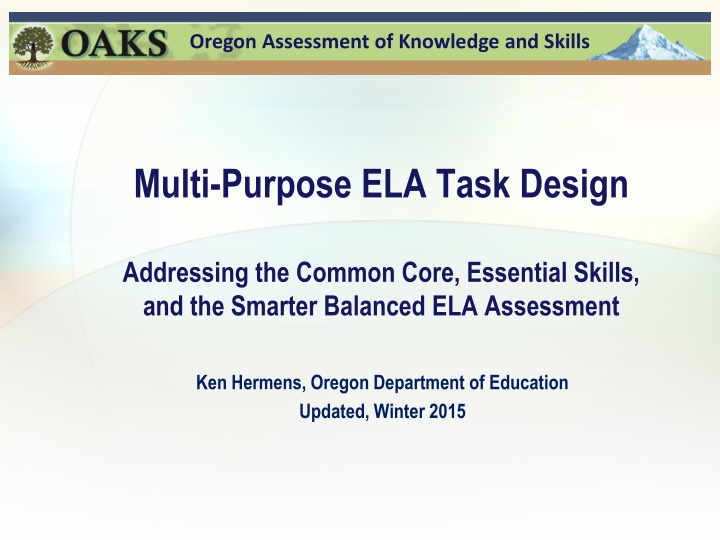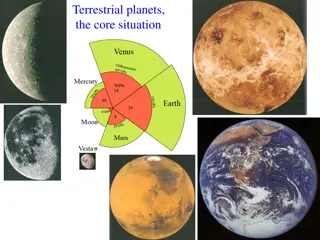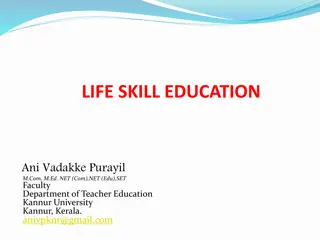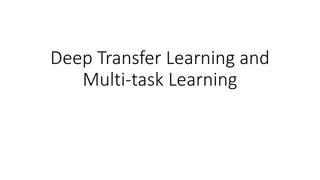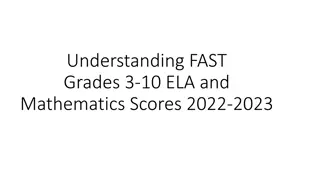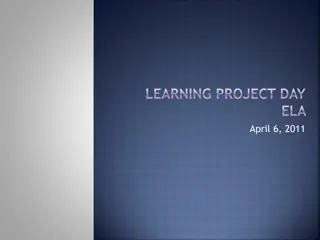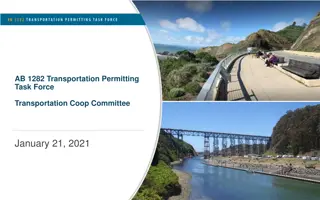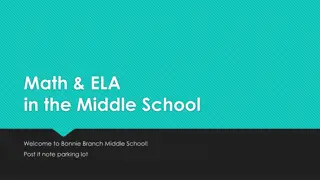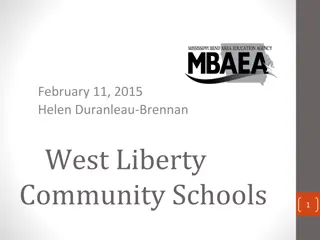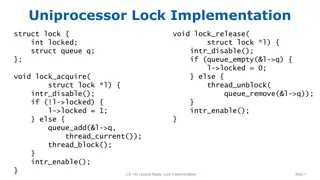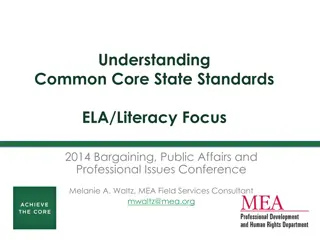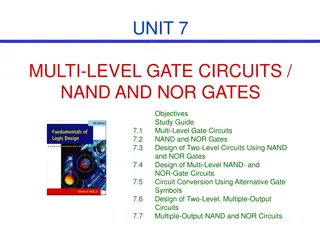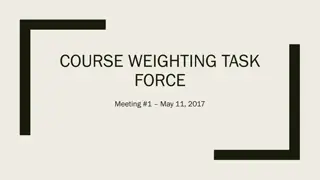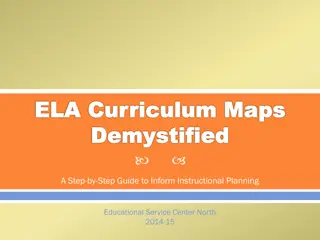Multi-Purpose ELA Task Design for Common Core Skills
How to align Essential Skills with Smarter Balanced assessments through effective task design. Learn how to create Work Samples for assessment documentation, score against criteria, and improve student learning opportunities.
Download Presentation

Please find below an Image/Link to download the presentation.
The content on the website is provided AS IS for your information and personal use only. It may not be sold, licensed, or shared on other websites without obtaining consent from the author.If you encounter any issues during the download, it is possible that the publisher has removed the file from their server.
You are allowed to download the files provided on this website for personal or commercial use, subject to the condition that they are used lawfully. All files are the property of their respective owners.
The content on the website is provided AS IS for your information and personal use only. It may not be sold, licensed, or shared on other websites without obtaining consent from the author.
E N D
Presentation Transcript
Oregon Assessment of Knowledge and Skills Multi-Purpose ELA Task Design Addressing the Common Core, Essential Skills, and the Smarter Balanced ELA Assessment Ken Hermens, Oregon Department of Education Updated, Winter 2015
SESSION OBJECTIVES Recognize that elements of the Common Core exist within the expectations related to the Essential Skills of Reading and Writing. Preparing students for Smarter Balanced Performance Tasks can also produce potential Work Samples for Essential Skills documentation. Work Samples can be scored against the criteria contained in a variety of scoring guides/rubrics. Effective task design can create efficiencies for teachers and opportunities for students to demonstrate a variety of skills.
ASSESSMENT GUIDANCE TYPES OF DECISIONS TO BE INFORMED TYPE PURPOSE Used to provide culminating evidence of performance against a defined learning target What standards has each student mastered? What grade does each student receive? Summative Predictive: What performance can be anticipated on the summative assessment? Evaluative: Is the curricular program or strategy effective? Instructional: How should the instruction and curriculum be adapted to better meet student needs? Mid-cycle Interim Results can be meaningfully aggregated and reported alongside summative Where can we improve instruction right away? Which students need specific help? Used to identify how teachers can adjust instruction to increase learning Formative
ASSESSMENT GUIDANCE Criteria 1. Clear Purpose Why am I assessing? What am I assessing? 2. Clear Learning Target(s) How can I assess it well? 3. Quality Assessment How will I ensure test conditions do not interfere with a student s ability to perform well on a test? 4. Proper Test Administration How will I share results for maximum impact? 5. Effective Communication of Results http://www.ode.state.or.us/go/LocalAssessmentGuidance
Performance Tasks and Common Core Skills Reading Anchor Standards Key Ideas and Details Cite specific textual evidence to support conclusions drawn from the text Determine central ideas or themes and analyze their development in a text Craft and Structure Analyze the structure of texts and how point of view/ purpose shapes the content and style of text
Performance Tasks and Common Core Skills Integration of Knowledge and Ideas Integrate and evaluate content presented in diverse formats and media, including visually and quantitatively. Delineate and evaluate the argument and specific claims in a text, including the validity of reasoning as well as the relevance and sufficiency of the evidence. Analyze how two or more texts address similar themes or topics in order to build knowledge or to compare the approaches the authors take.
Performance Tasks and Common Core Skills Writing Anchor Skills Text Types and Purposes Write arguments to support claims using valid reasoning and relevant and sufficient evidence. Write informative/explanatory texts to examine and convey complex ideas clearly and accurately. Production and Distribution of Writing Produce clear and coherent writing in which the development, organization, and style are appropriate to task, purpose, and audience.
Performance Tasks and Common Core Skills Research to Build and Present Knowledge Conduct short as well as more sustained research projects based on focused questions. Gather relevant information from multiple print and digital sources, assess the credibility and accuracy of each source, and integrate the information while avoiding plagiarism. Draw evidence from literary or informational texts to support analysis, reflection, and research.
Essential Skills Work Samples Reading Work Samples One of the alternatives for students not yet meeting on the State Reading Assessment Two Reading Work Samples are required; at least one of the two must be based on an informational text. Scored in three dimensions or traits on the Official Reading Scoring Guide: Demonstrate Understanding, Develop an Interpretation, and Analyze Text To meet, samples must receive a score of 12 across the three traits, no individual score less than a 3.
Essential Skills Work Samples Writing Work Samples One of the alternatives for students not yet meeting on the State Writing Assessment Two Writing Work Samples are required; at least one of the two must be expository or persuasive. Four required traits on the Official Writing Scoring Guide: Ideas and Content, Organization, Sentence Fluency, and Conventions To meet, samples must receive a score of 4 in each of the required traits.
TRANSITION Oregon Administrative Rule 581-22-0615 The Assessment of the Essential Skills 1. Students will be able to use Essential Skills assessment evidence collected prior to the transition to Smarter Balanced (as long as it comes from the approved list of assessment options). 2. The approved assessment options will remain in place through the transition to Smarter Balanced (state test, other standardized tests, work samples) 12th Grade Retest opportunities for 2014-15, Reading (3), Writing (1), Math (3)
WORK SAMPLES Late fall 2014-15 ODE released secure Essential Skills work sample tasks: 35 reading, 35 writing and 35 math. Five of the tasks included student exemplars for training purposes Accessed through WESD site Blended work samples reading/writing, science/writing, and science/math Smarter Balanced- Like Work Samples
PERFORMANCE ASSESSMENT . . . is learning by doing. . . . links curriculum, instruction, and assessment. . . . is assessment for and as learning. . . . targets skills and knowledge that matter.
Characteristics of Performance Tasks Require student-initiated planning, management of information and ideas, interaction with a variety of other materials. Require production of extended responses, such as oral presentations, exhibitions, and other scorable products, including more extended writing responses which might be revised and edited. Reflect a real-world task and/or scenario-based problem; tasks are multi-stepped and allow for reflection and revision.
Smarter Balanced Performance Tasks Allow for multiple approaches to developing and organizing ideas Measure capacities such as depth of understanding, research skills, complex analysis, and identification/providing of relevant evidence Represent content that is relevant and meaningful to students
Creating a Performance Task Step 1: Identify a Topic or Theme Step 2: Locate Resources/Build a Text Set Step 3: Draft the Task Step 4: Format the Task Step 5: Administer the Task Step 6: Score the Task Step 7: Analyze the Results Step 8: Revise the Task
Creating a Multi-Purpose Task Step 1: Identify a Topic or Theme Questions for Consideration: Curriculum-embedded? Part of a thematic unit? Is the topic high interest? What are the available resources? What would be appropriate for this grade level? Does the topic/theme allow for multiple perspectives?
Creating a Multi-Purpose Task Step 2: Locate Resources/Build a Text Set Considerations: Texts should be of a suitable length and number. Texts should be at an appropriate level of complexity (use Quantitative and Qualitative measures). Stimuli from a variety of digital or media resources (traditional text, audio, video, graphics) A balance with multiple perspectives
Determining Text Complexity Text complexity is determined by: 1. Quantitative measures readability and other scores of text complexity often best measured by computer software. 2. Qualitative measures levels of meaning, structure, language conventionality and clarity, and knowledge demands often best measured by an attentive human reader. 3. Reader and Task considerations background knowledge of reader, motivation, interests, and complexity generated by tasks assigned often best made by educators employing their professional judgment. Reader and Task
Determining Text Complexity Step 1: Quantitative Measures Measures such as: Word length Word frequency Word difficulty Sentence length Text length Text cohesion Reader and Task
Determining Text Complexity Step 2: Qualitative Measures Measures such as: Levels of meaning Levels of purpose Structure Organization Language conventionality Language clarity Prior knowledge demands Reader and Task
Determining Text Complexity Step 3: Reader and Task Considerations such as: Motivation Knowledge and experience Purpose for reading Complexity of task assigned regarding text Complexity of questions asked regarding text Reader and Task
Creating a Multi-Purpose Task Step 3: Draft the Task Considerations: Include a classroom activity? (Smarter Balanced Model) Determine order of selections Draft scaffolding questions (consider purpose) Select graphics/clip art/pictures to break up text Define parameters of the task (wording of the assignment)
Creating a Multi-Purpose Task Step 4: Format the Task Considerations: Craft the directions and brief introductions Select an appropriate font style and size Use formatting as a cue to comprehension Allow margin space for margin notes Include graphic organizers as appropriate for responses to questions Allow adequate space for responses
Creating a Multi-Purpose Task Step 5: Administer the Task Considerations: Timed vs. Power Tests (SB is NOT timed) Spread over multiple sessions, as needed Determine if accessibility options might be appropriate to allow students to engage in the task Certain resources might be allowable (dictionary, thesaurus, spell check)
Creating a Multi-Purpose Task Step 6: Score the Task Considerations: Determine skills/purpose for your evaluation Select the appropriate rubric/scoring guide Review exemplar papers or anchor sets to recalibrate, as needed Consider, as appropriate, all responses provided by the student (margin notes, short answer, essay)
Creating a Multi-Purpose Task Step 7: Analyze the Results Questions for Consideration: Are there some items/aspects students consistently struggled with? Is this an instructional issue? Are there questions students seem to consistently misinterpret or misunderstand? What revision(s) might clarify what is being asked? Is there a lack of evidence in order for students to match the criteria on one of the scoring guides? Do you need an additional question or questions?
Creating a Multi-Purpose Task Step 8: Revise the Task Considerations: Add additional questions, as needed, to elicit evidence from student responses that was missing. Revise questions which turned out to be imprecise or ambiguous. Replace questions that didn t work with better ones. Revise directions so students have clear targets/ expectations.
Additional Performance Task Guidance Within a school, multiple tasks should be used to prevent students from sharing information about task content between test sessions. Students can be given some choice among reading and writing selections to address interest and accessibility. Prose selections for reading work sample stimuli should be approximately 1000-2000 words. The recommended Lexile level for text difficulty for HS work samples is around 1070, but a range 950-1200 is reasonable.
Sample 1 Multi-Purpose Performance Task On-Demand Performance Task: Argumentative A Roundabout Way to Relieve Traffic Congestion Classroom Activity: Video Clip as Stimulus Four articles for use as resource materials Three scaffolding questions (two graphic organizers) One argumentative essay prompt
Sample 2: Embedded Performance Task Curriculum-Embedded Performance Task: Explanatory Classroom Activity: Video Clip as stimulus Five Resource Articles to use as source materials Four scaffolding questions Essay Prompt The Crucible: Salem Witch Trials and McCarthyism
Links to Resources Smarter Balanced Assessments http://www.smarterbalanced.org/smarter-balanced-assessments/ http://www.smarterbalanced.org/practice-test/ Common Core Home Page http://www.corestandards.org/ Text Complexity http://www.ccsso.org/Navigating_Text_Complexity.html http://achievethecore.org/page/642/text-complexity-collection Essential Skills Assessment http://www.ode.state.or.us/search/page/?id=2042
